Story – Chris Hector Photos Roz Neave and Jessica Stammer

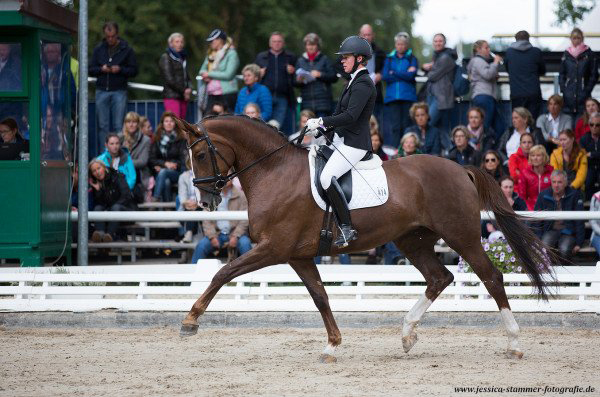
Fraconi W at the Bundeschampionate – this time with Kira Wuldferding in the saddle.
Photo Jessica Stammer
It was no surprise to see a video pop up on the facebook feed of Brigitte Wittig winning a young dressage horse class at with a stunning young mare, Franconi W, and even less of a surprise to discover that the mare was bred exactly following the formula Wolfram outlined to me last time I visited him. You have created a dynasty with Breitling, now he has gone, where do you turn? Foundatation!I
I always enjoy turning into the drive of Wolfram and Brigitte Wittig’s home, near the German town of Rhaden. The stables are beautifully appointed, but with not a hint of pretension. There are no gold door handles here, just spacious functional stables, and green fields with mares and young horses. Wolfram is more of the same, no pretension, down-to-earth wisdom, and a wicked sense of humour.
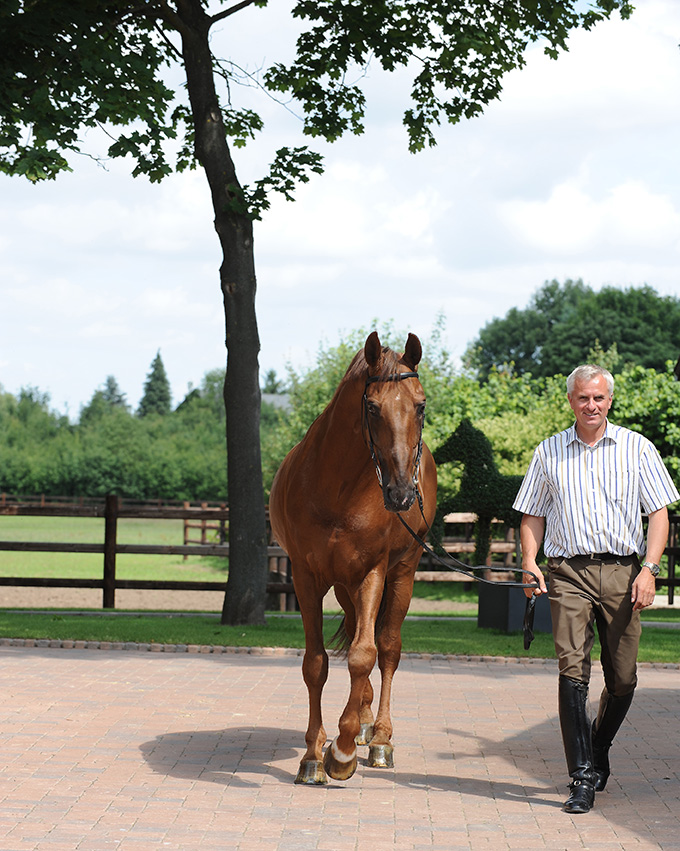
Wolfram and Breitling, the horse that helped him prove you could both ride and breed your own Grand Prix horses,
The set-up here is unique. I know of no other place where the fusion between high-level competition riding and horse breeding is so complete. It is almost as if the riding hall is a test tube to check the success of Wolfram’s breeding program.
A large part of that breeding program stems from the stallion at its heart, Breitling. The chestnut stallion died in 2015 but his heritage is well and truly alive in Wolfram’s breeding lines. Amongst other things, I was interested to see where Wolfram would go in his program…
Before you read any further, a warning, in some of the photos the riders elect to ride without helmets.
Wolfram used Paul Schockemöhle’s stallion, Foundation (Fidertanz II / De Vito), and looks as if the cross over Breitling really works, if the handsome bay four-year-old being ridden by the Danish working student, is anything to go by…
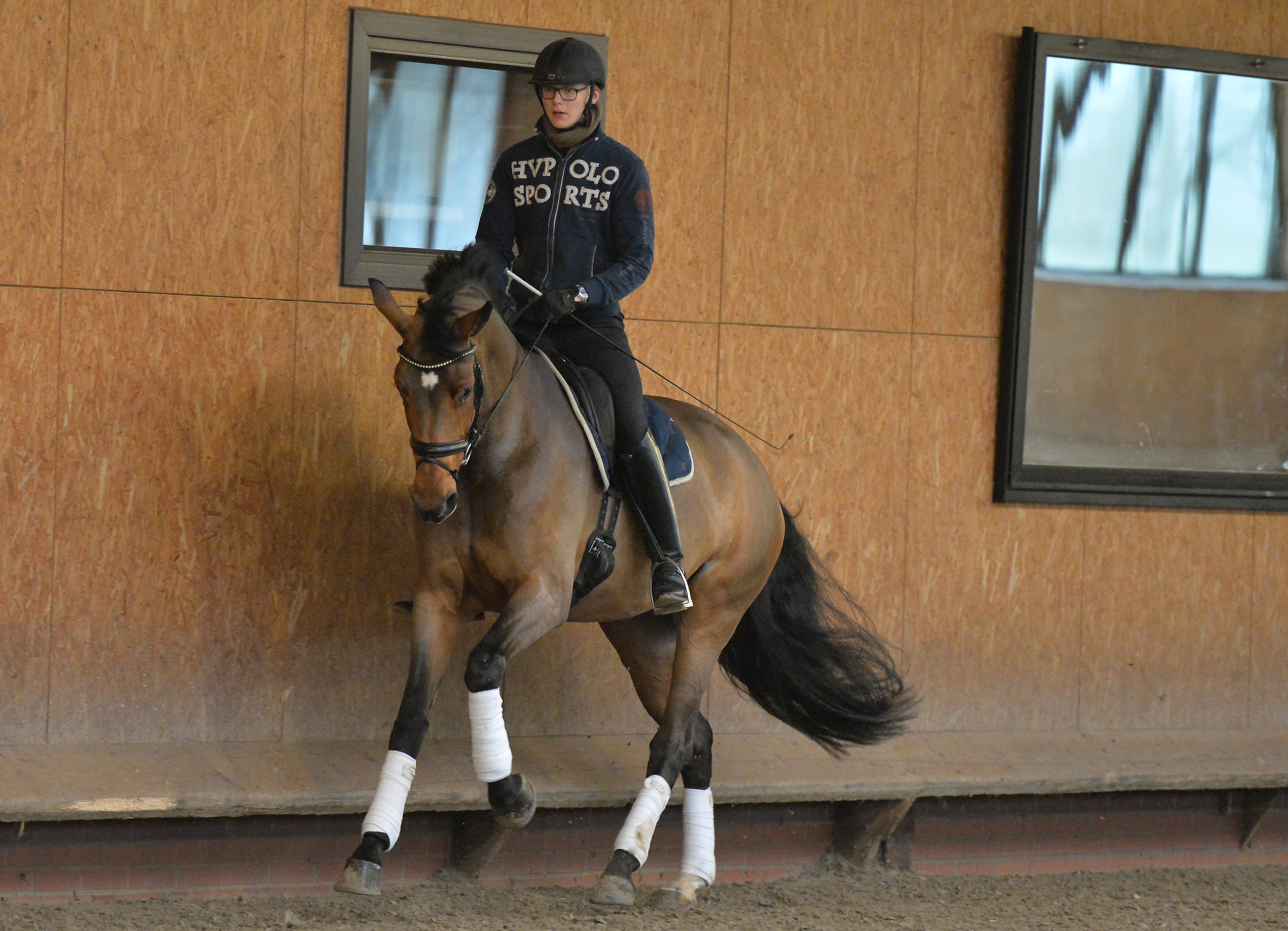
Wolfram remarks: “This is for me, natural balance.” And it is. Sure the nose is a touch behind the vertical, but the horse is offering, looking for that longer outline. Now he pokes his nose out, but he doesn’t fall on his forehand.
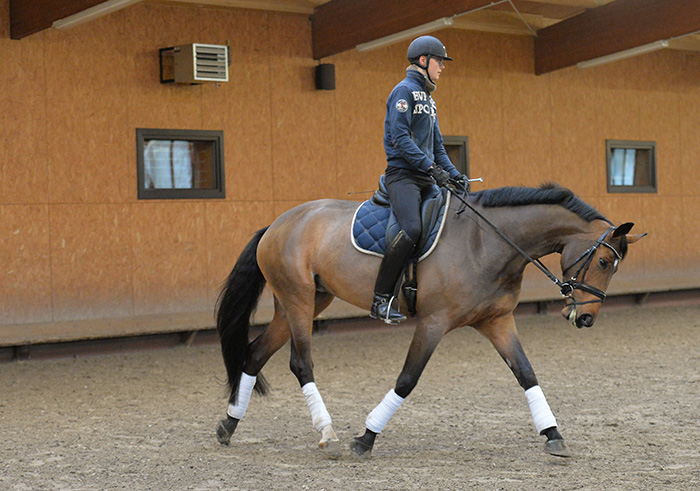
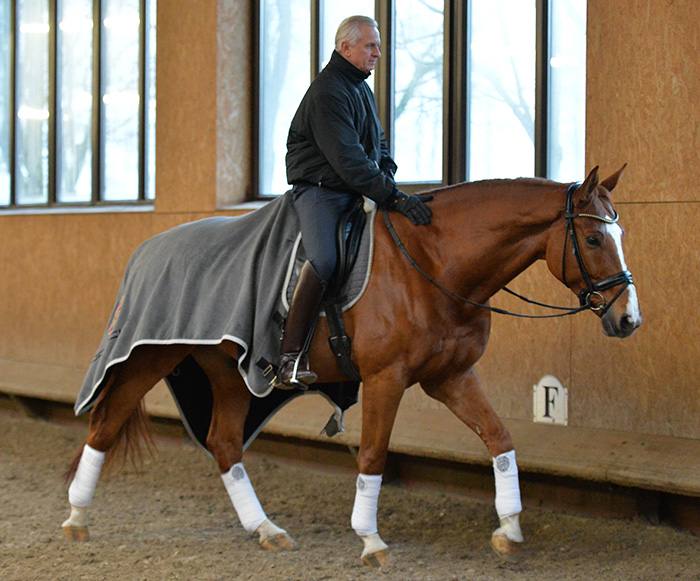
Next Wolfram and the Boston/Bismark enter the arena
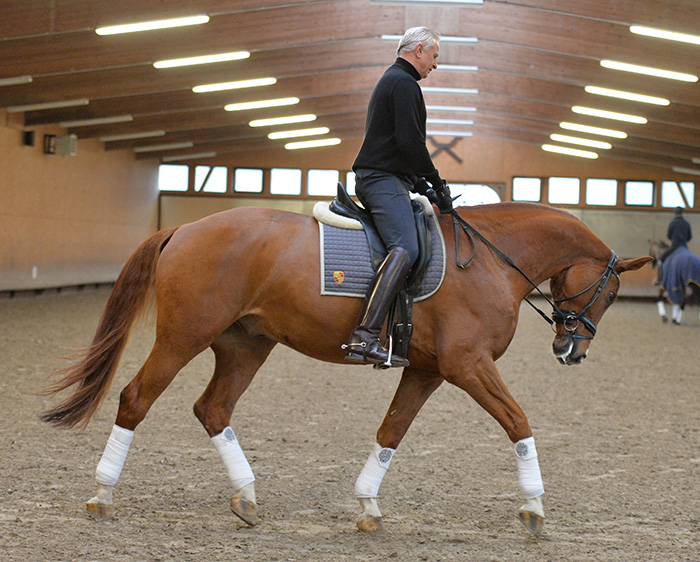
Wolfram has moved into an easy stretching trot with his Boston/Bismark, and like every horseman everywhere in the world, he starts with the horse just a touch behind the vertical, that’s what real trainers in the real world do, and it has nothing to do with rolkur.
more follows
Good training is logical. You don’t need to be told why the rider is doing it, you can see the thinking in action…
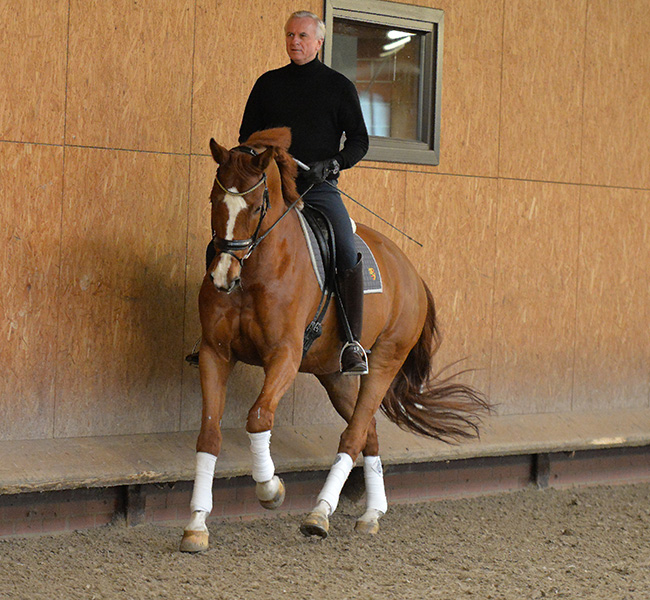
A little shoulder fore in the canter, everything so calm and unhurried, a very shallow half pass to the wall, and the gelding melts into a walk.
Another canter half pass, this time with a little more flexion, an easy flying change, and half pass the other way, straighten a couple of strides, effortless flying change, shoulder in canter on the long side, super calm, super clear walk diagonal…
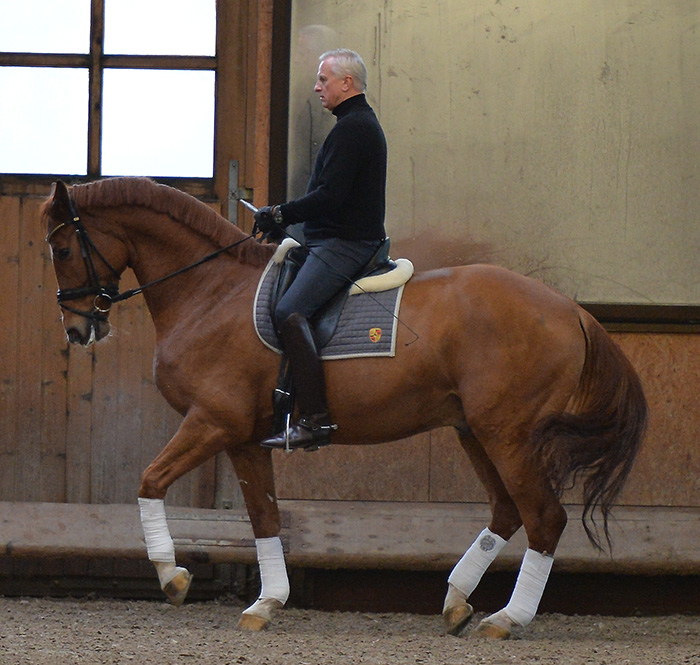
Wolfram has the gelding trotting now, riding him up more to the vertical, there’s a lovely relaxed cadence in the trot, a few baby steps of advancing piaffe, out into a relaxed walk, and now a little baby passage. Wolfram has that same quality the late great Herbert Rehbein had; of surrounding the horse with his body, gently squeezing the horse into collection.
The horse had recently had some time off, so no more today.
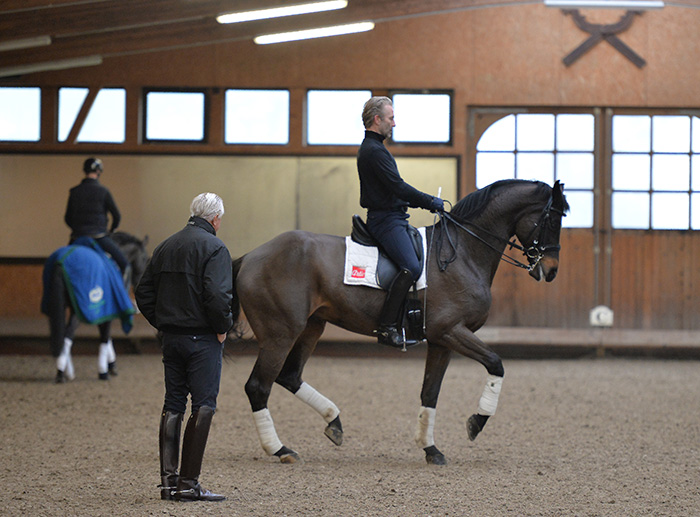
The Belgian rider, David Engelen is in the arena on Royal Rubinstein, and Wolfram shows another side, as he demands more collection in the canter. Two times changes, Wolfram is barking instructions, David certainly doesn’t need a head set, now the ones, and David gives the reins and flows calmly into walk and just as calmly into passage. Takt, takt, TAKT, TAKT – if you want proof that the rhythm of the piaffe is faster than the rhythm of the passage, just listen to the ‘takts’ as they rattle like machine gun fire.
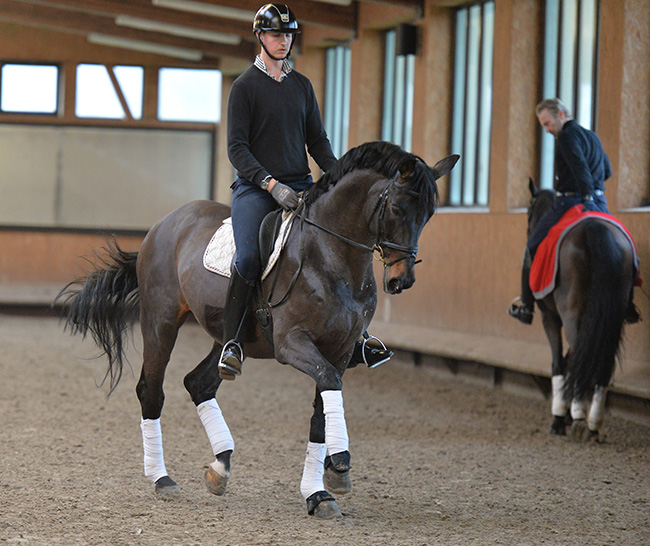
Barclay, one of the Breitling/Fabriano crosses produced to the Grand Prix level by the Wittigs, and still going strong at 19.
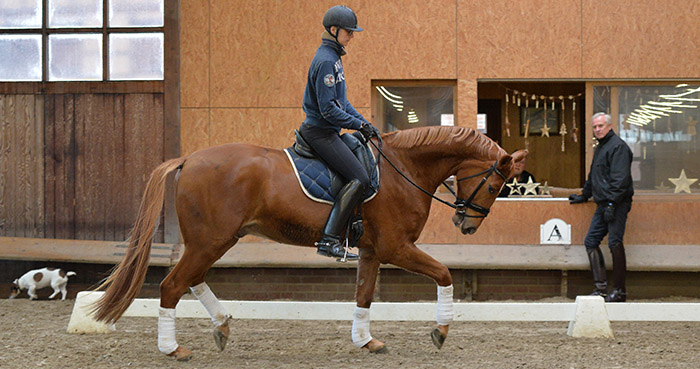
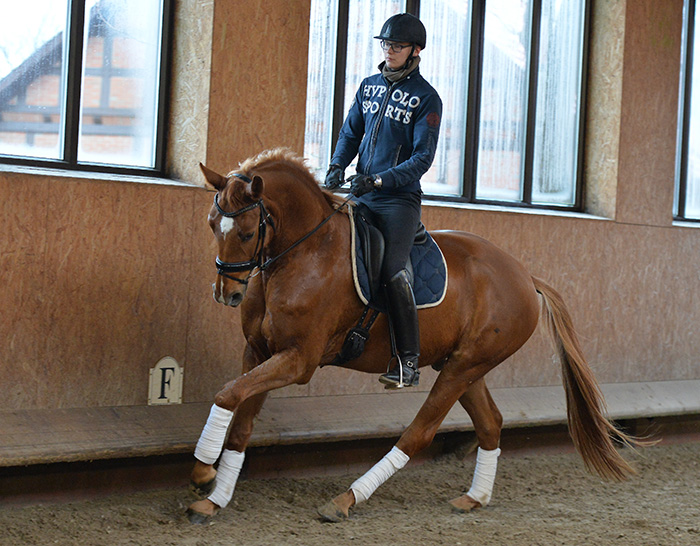
And to balance the age spread, there’s a chestnut four-year- old, again Foundation over Breitling, not long under saddle.
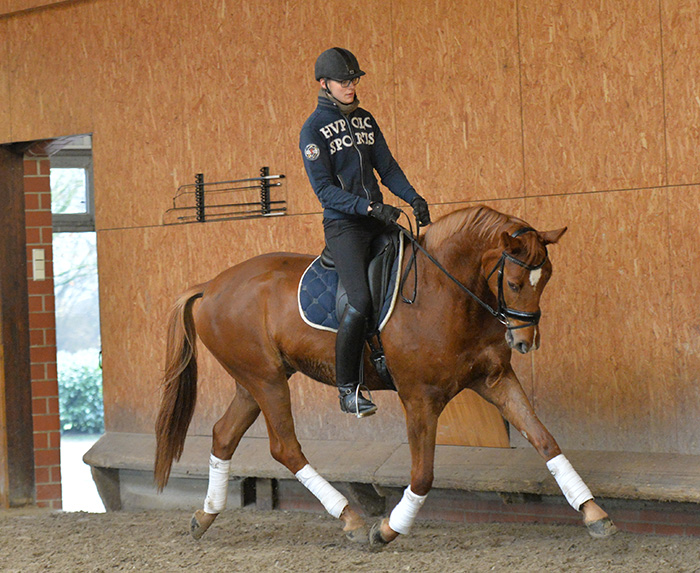
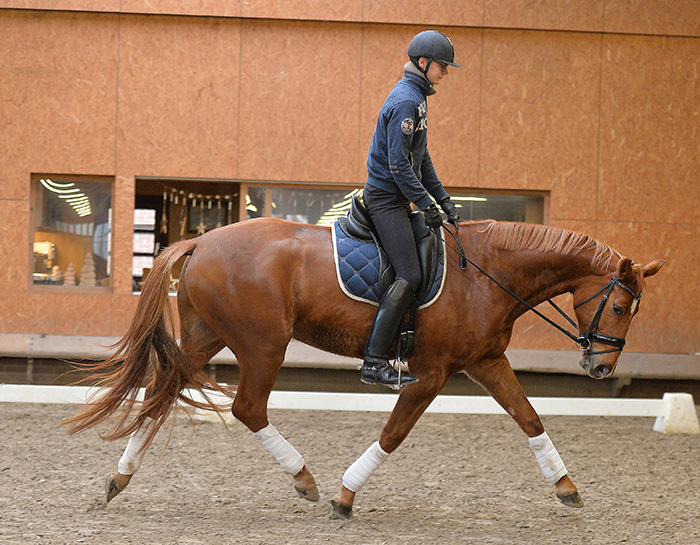
This is another lovely mover, no wonder Wolfram says, ‘Foundation is doing a really good breeding job with my Breitling mares’.
more follows
“Now here is something for you, everyone is talking LDR, or short in the neck, look now, I’ll show you some work in hand. People say there must be a secret to in-hand work, let me show you…”
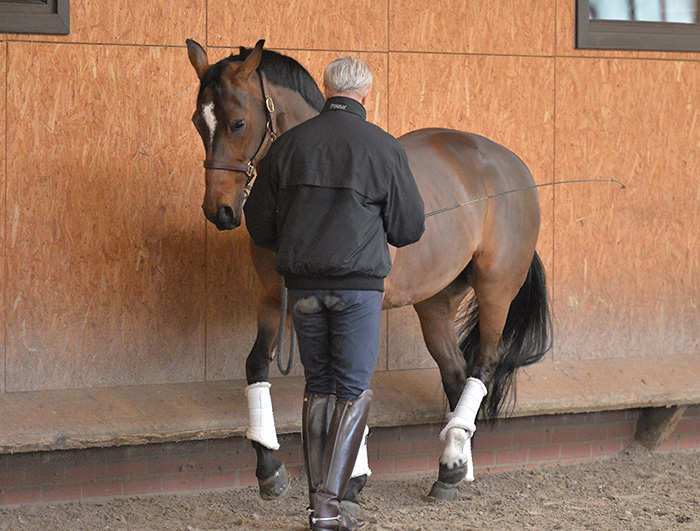
The demonstration model is a 12-year-old mare, by Breitling out of a Warkant mare, and Wolfram’s in hand demonstration is she is wearing just a headstall!
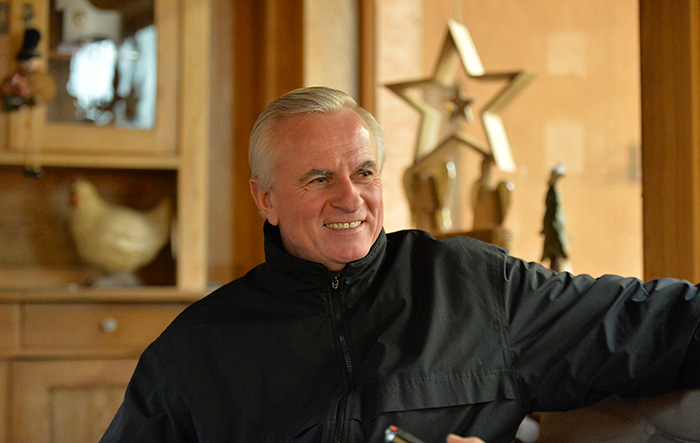
Getting Wolfram to sit down in front of a microphone is not all that easy, the wise-cracking jokester tends to dry on you.
What is your opinion on the campaign spreading the message that low deep and round is just the same as rolkur, and that it is scientifically proven to be bad for the horses, this is so stupid, all horsemen start their horses like you do, low and slightly behind the vertical…
“For me the main target is keep the horses healthy, I’m not focused on low, deep and round or anything like that, keep the horses healthy and make sure you have a happy athlete.”
But you start all your horses quite deep, a little bit behind the vertical…
“Yep, but not pulled in. They are in a relaxed mode, sometimes they are behind the vertical, sometimes they are ahead of the vertical, it is not fixed. In every other sort of sports training it is not expected that every photo has to be perfect, but training horses, every picture must be perfect, and this is not possible.”
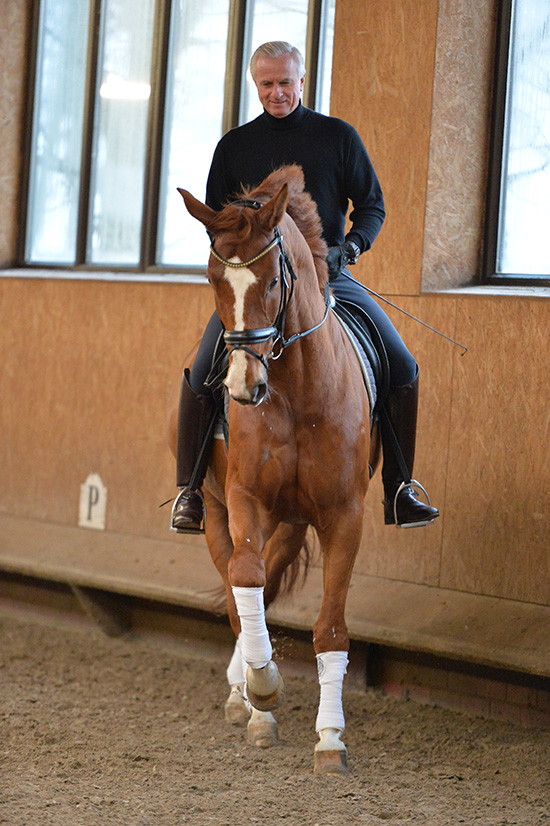
But the horse you rode, when he started he was a little behind the vertical, but when you rode the half pass and increased the bend, he came up…
“That must be possible, otherwise they have been trained wrong.”
You also have an ability to keep the horses calm, even with a young horse, you can ask for short steps and then you drop the rein and it is totally relaxed…
“This is part of the training and hopefully we can re-produce it every time because it is important not to limit the walk. If you have a good walk, keep the good walk. You train them, up and down, up and down, that’s how you train them, this means power and relax, power and relax.”
How did you get into dressage? Who started to teach you to ride…
“If you watch the horses out of the fields, then you learn a lot from the horses. They don’t run for a whole hour, but also, they don’t just stay on the one spot, it is always a mixture. Nature teaches us a lot more than a lot of teachers can.”
How did it start – did your family have horses?
“No, I started at the age of 13, with riding. At twenty I passed the tests and became a professional, and then three-and-a-half years later, I became a riding instructor. Then I also passed the examination to be a Master for Breeding.”
Which teachers?
“Very important for me was Walter Biedermann from the Spanish Riding School, but he lived and worked in Germany. It was a very good combination from this – excuse me for the words – but somewhat old-fashioned way, in combination with the modern competition horse way. He was a very good teacher.”
“After that I trained a lot with Mr Rehbein, with Mr Boldt, Klaus Balkenhol, Jo Hinnemann, Jean Bemelmans… you have to have an open mind all day long.”
“My way of training is that I am the breeder of the horses, so I am totally focused to keep them healthy and sound.”
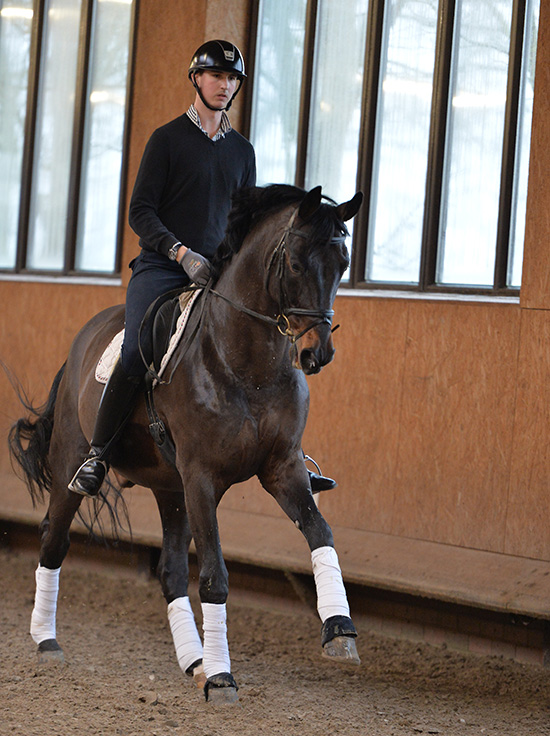
When you look in your school and see 19-year-olds doing one times changes – Barclay demonstrates – it would seem you have been successful…
“I like that a lot. I have my mares still, 25, 26 years of age, they are still here, with their progeny, the whole family is still here.”
Breitling was an amazing stallion given the very small number of mares he covered and the number of Grand Prix horses he produced…
“For me more important was Breitling’s father, Bismark. I had four Grand Prix winners by Bismark, two stallions, the first Burlington and Breitling. I was always pretty sure that my horse was not a modern horse, that I know, I am not blind, but in my opinion success will never be un-modern. It depends not how the horse looks, it depends only on the quality, the rideability, the character and the gaits.”
But the most successful Grand Prix horses – like Valegro – they don’t look so modern, and we don’t see so many with the long long necks and the elegant bodies in the big sport…
“If the horse is useful, no-one asks ‘is he one for the catwalk?’ The problem with the young horse classes is if they are not so modern, they are difficult to sell, and in the young horse classes they are asking different things, not things that are later tested in the Grand Prix. It’s good for the business that every year we have new young horse champions, but later on, the Grand Prix horses, they definitely look different from the young horses.”
“Then you have, for me, a wonderful sporthorse like Gigolo. He was doing a perfect job with Isabell, it was superb. Then you have Anky’s Bonfire, Salinero, Satchmo, Parzival, Totilas, Valegro – all different horses, but top horses, not the young horse class winners.”
Why do you like Foundation so much?
“The horse was at the stallion selection at Hanover and they said ‘no’. I was a member of the grading committee for Oldenburg, and there he was ridden, so it was about three months later, and Anja Engelbert was riding him. He is a big horse, how was this girl going to manage his size, that was unbelievable. These beautiful gaits, and always balanced, it never looked difficult for him, always easy. It is difficult for horses to cross my border to be used as a stallion, but he did it.”
What is he putting on the progeny?
“Especially a very good mind and beautiful gaits.”
When you are riding you are always straightening the horse, it is not easy to see when you are riding, but you can see it in the photographs…
“If the horse is straight, not with the haunches in or out, it depends not on the neck, but on the body. The body is from the shoulder and that’s how you get the horses straight, you get both sides in the same length, that’s it.”
You did a lot of half pass work with your six-year-old…
“On some days we are going to train half passes, on others, the piaffe / passage, the next day, we go for the pirouettes. He is a young horse… then later on, you put it together. It is not possible with a six-year-old horse to put everything together – then the body stops, and it is not my job to make him unsound.”
“I showed you this because they are always talking, how hard the work in hand is, for me it is nothing.
What has made German dressage great?
“I think it is the combination of very good breeding products, because we have very very good studbooks, and the education and the training. I’m very happy now we are seeing some good riders who are starting to breed their own horses. For me, this makes Germany very powerful because the combination: breeding, training, and the history, these three points are for me the reason we have been so strong and successful.”
When you started with the Thoroughbred mare, Devisa, people were telling you it was impossible…
“For me, it is important when I am talking about something, I ask myself, can you prove it. I can’t say, oh I have a lot of experience with young horses, about breeding, on paper! For me it is a reality show, nothing to do with paper – we have so many people who know a lot on the paper, but they don’t prove it. That is worth nothing.”
“We have had a Bundeschampion, World Champion, Burg-Pokal winner, Louis d’Or winner and Aachen and Hickstead winners. Everything here, I like to prove. It’s not important to talk about it, and believe me, I am never looking backwards, I know what we have done, but I am never looking backwards, I am looking forward. For me what is important is the next horse, the other one is history. The next one is important, I’m burning for the next one. The old ones are nice, I say to my students, you go on the ones that are thirteen, fourteen, I like that, they do the job, but for me, the four-year-old, five-year-old, six-year-old, that’s my job.”
“Look at Isabell, she starts with young horses. Okay she got lucky with Weihegold, but normally she starts with young horses. She is educated to ride the young horses and she can handle the problems. If you only ride the old horses, you cannot handle the problems because the old ones don’t make mistakes, no bucking, no nothing, but Isabell she knows how to handle it.
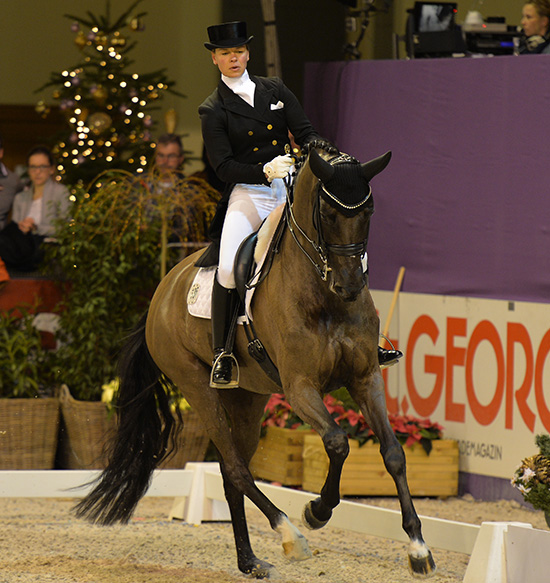
Kira Wulferding and Soiree d”Amour, a finalist at the years Nürnberger Burg Pokal
That’s why I like to work with Kira Wulferding, or Matthais Bouten, you know, they like to handle it, they are able to handle it .”
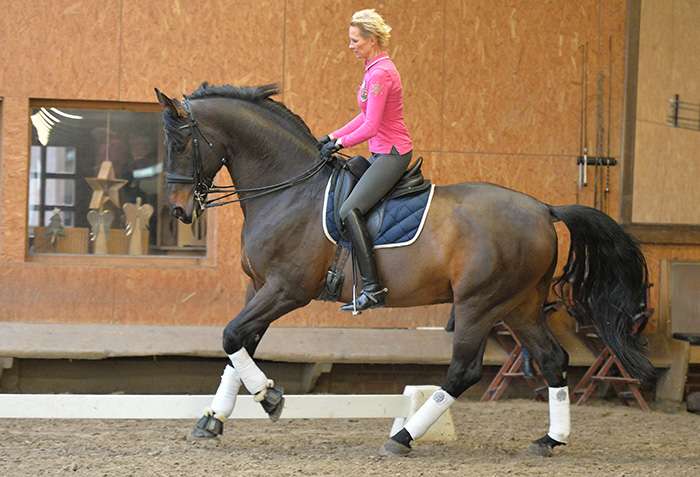
Brigitte and another of the Breitling/Fabriano crosses competing at Grand Prix level
“My wife, she can ride six, seven horses a day, she can handle it. The others, you sit them on the horse and they like to compete, but until they learn to handle it, they are not good riders. They cannot produce the next horse. It must be inside of you, that you like to do it, then you can support the others.”
“For me it is important every time to judge myself. I don’t want to sit on the horse like a hunchback – watch it in the mirror, every time, criticize yourself, prove yourself, judge yourself. And if you are not asking, is it really right what you are doing – because you are getting so many criticisms, this horse is too low, this one is not good enough, old fashioned. Everybody is criticizing you, but… prove yourself! It’s easy to say, it’s easy to write, but to prove it in reality that’s more difficult, but I love it.”
“I am lucky in Germany because if I have some questions, I can ask colleagues, maybe I can ask Rudi Zeilinger, because he’s always straight, when I ask Rudi, he says, that’s good, that’s bullshit. He’s not like some of the others, oh everything is so ,nice and rose coloured and wonderful. He’s straight, he says good or bad. This is important. He’s a guy not talking about history, he likes to prove it.”
“The ones that like to criticize, they forget very quickly what they have done in the saddle, they forget very quickly. In that moment, the past was so wonderful – the First World War must have been a wonderful thing? I can’t agree…”
“To be a trainer, first of all you need a lot of basic knowledge: how the horse functions. Then you have to know when to learn, and when to accept – the whole construction and mentality of the horse is only for one thing, escape. This is the whole way horse the horse works, the joints, everything, all for this direction. Then we start to train the horse’s body, that’s why I dislike to say we are riding horses, we are training muscles, ligaments, tendons.”
“Day by day, we like to keep the horse together, but sometimes we are forgetting the basic of a horse, and this is to escape. You can ask the rider, it’s always easier to pull than to let him go – but keep the horse fresh, let him buck, everything, it’s not a problem, if they are escaping be happy, if you have to use always be using driving aids, that’s not riding, that’s path of slavery.”
“If you have the knowledge of how it works physically with the horses, then you learn different ways of training, and there is not only one way. There are a lot of different ways – there is not just one strict rule, that is not possible in my opinion.”
Do you change your style of training depending on the rider you are working with? I’ve seen you work with Kira and you hardly say anything, but with David today, you were very directive – do different riders respond to different approaches?
“Different riders, different horses, different levels, everything comes together, and then after a couple of training sessions you hope that the riders are taking in your philosophy, otherwise you are always starting in the same place, and that is wrong, you like to see improvement. If you start always at the same place, the same spot, then it gets boring.”
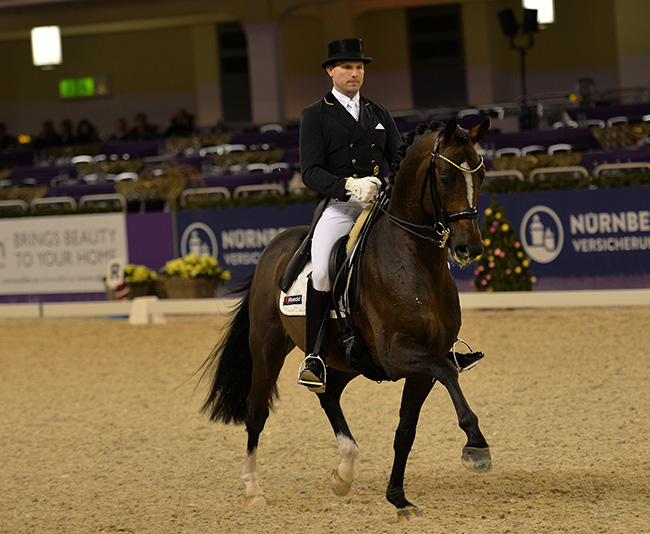
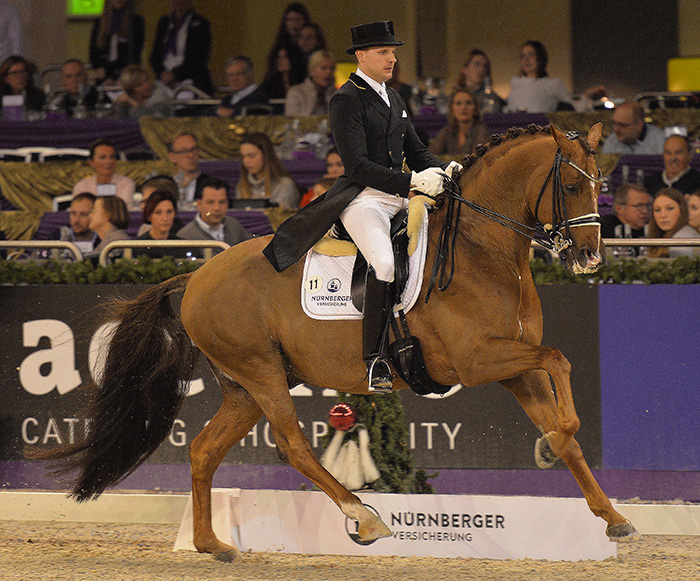
Matthias Bouten had Quantum and Bodyguard
You had two riders with three horses in the Nürnberger Burg-Pokal?
“Four horses with three riders. Matthias Bouton had two, Marcus Hermes and Kira Wulferding. It’s a good team, and if you watch them riding in the test, it must be beautiful and easy. They are not weight lifters, they are more dancers for me – and if it looks like this, then I am happy. If you watch Matthias, or Marcus or Kira riding, it is more of a two-way communication system and not a fight, the fight is not my way of riding. Why should we fight with the horses? Why? If they fight against us, they will be always the winner. They are more powerful, they are stronger, the rider will always be the loser.”
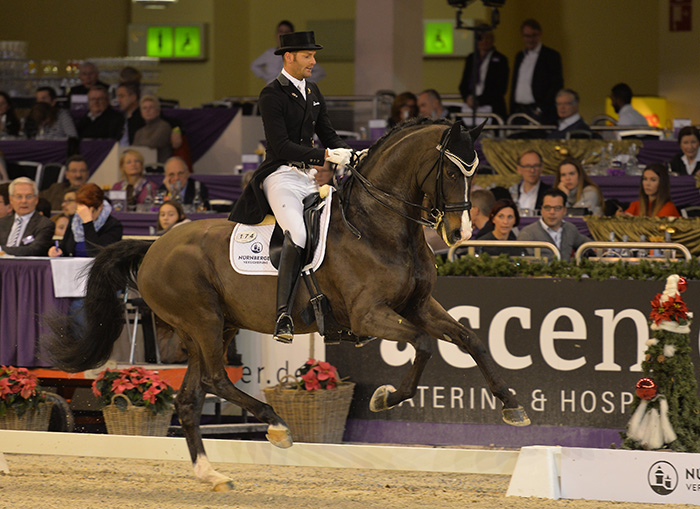 Marcus Hermes and Abgglen
Marcus Hermes and Abgglen
What amazes me Wolfram is when you see someone ride properly – like the Danish boy you have here now, he’s not famous or anything, but he is correct, and it’s good to look at because the horse is soft in the back, nice in the hand, and when you ride like that, you get a reward – but the people who ride their horses and make them frightened, who use tension to create movement, then the horse’s back is hard, they need muscles in their arms, they don’t look happy when they ride – so why do people ride the bad, aggressive way, when the good way is so much nicer for the horse and the rider?
“I won’t say ‘good’ or ‘bad’ but if you get the bonus, if you get good marks, even if it looks strong, or not happy for the horse, if you get the good marks why should you change your system?”
But that is changing now, the judges are not giving big marks for tests that look tense and aggressive? Now the judges are looking more for harmony…
“That’s a quite difficult question, I’m pretty happy if they detect if the horse is sound or not. This is the first step…”
It should be noted that we are all laughing out loud at this point in the conversation.
“Because the job is to protect the horses, and not the judges. The rider is only doing what he gets good marks for – that’s all. A soccer player plays to make a goal. That’s it, a rider likes to have good marks. A showjumper likes to be mistake-free. If you get a bonus for some lucky pictures, I’m not criticising, they must believe it’s right, they have to look into the mirror every day. We have to learn to discuss, we are all sitting in the same boat, now we need to learn to row in the same direction because this is a wonderful sport, we have a wonderful animal, and we are the only sport, that is done by males, done by females, and we compete together. Our age is not limited like the soccer player who is finished mid-thirties, we have to learn to go public with that – it’s more important than any other thing. Even in showjumping you don’t see so many good female showjumping riders, it’s perfect for us – but no-one talks about this, we talk about low deep and round, the bullshit things, but we are really not selling our sport.”
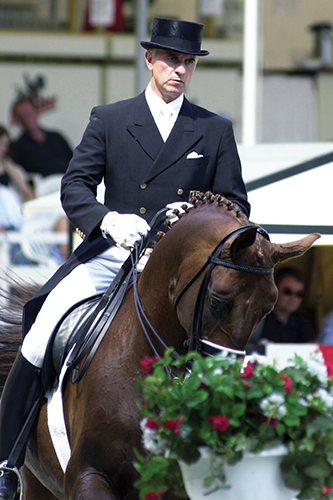
Wolfram and Breitling, the stallion that founded a Dynasty
Breeding in Australia in the 2023 season?
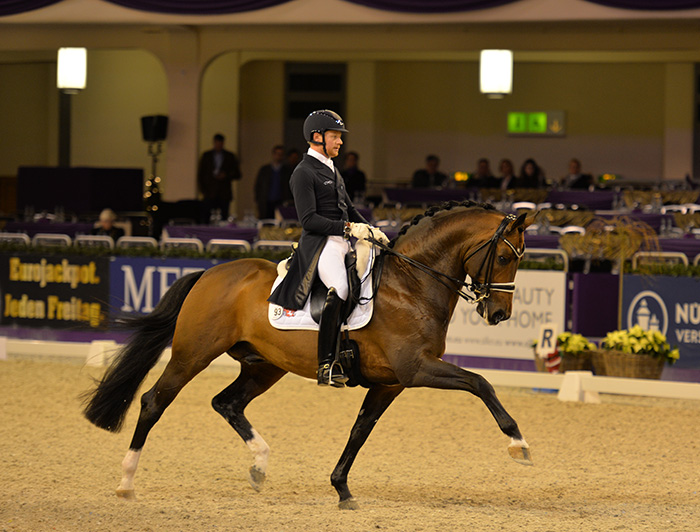
Foundation – a winner and a sire
Or a Hanoverian ‘B’ line representative? Go to www.ihb.com.au
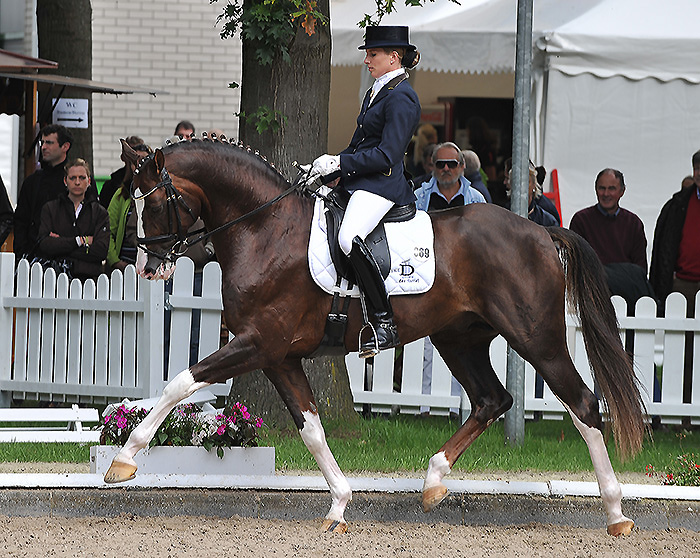
Benicio – plus many more…
ends



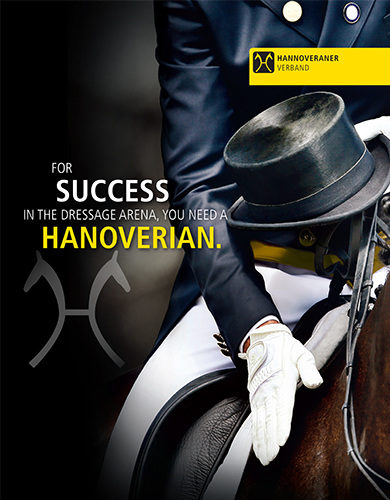
Thanis for the comments re helmets. Sick to death of the nanny state. What an adult chooses to wear is nobody’s affair. And it’s a great interview too.
I really like the way this article looks at how important getting the basics is & an open-minded attitude, and then applying them to breeding, riding & training…and life. I think that Herr Wittig’s comments about not raising the fact that riders of both sexes can compete against each other is a good one. Along with the fact that riding is a good form of exercise & riders can continue to ride for many years.
Brilliant article, and so correct !!
I love seeing all those beautiful Fabriano descendants featured in your photographs. Australia’s own gorgeous Fisherman’s Friend was of course a Fabriano son, and as the really lucky owner of a “Fish baby” I can attest to the brilliance of that line, particularly noted for their good temperament and trainability. Good to see them appreciated by a master.
Brilliant written! The Wittigs are true horsepeople and we wish we could come there more often to train together , eat together and go ahead with the competition who knows more jokes Wolfram or me… even our son Konstantin (showjumper) is a big fan of Wittig and his philosofi !
Great article… wonderful philosophy. Lovely horses. I Have 2 Foundation fillies and they are super!